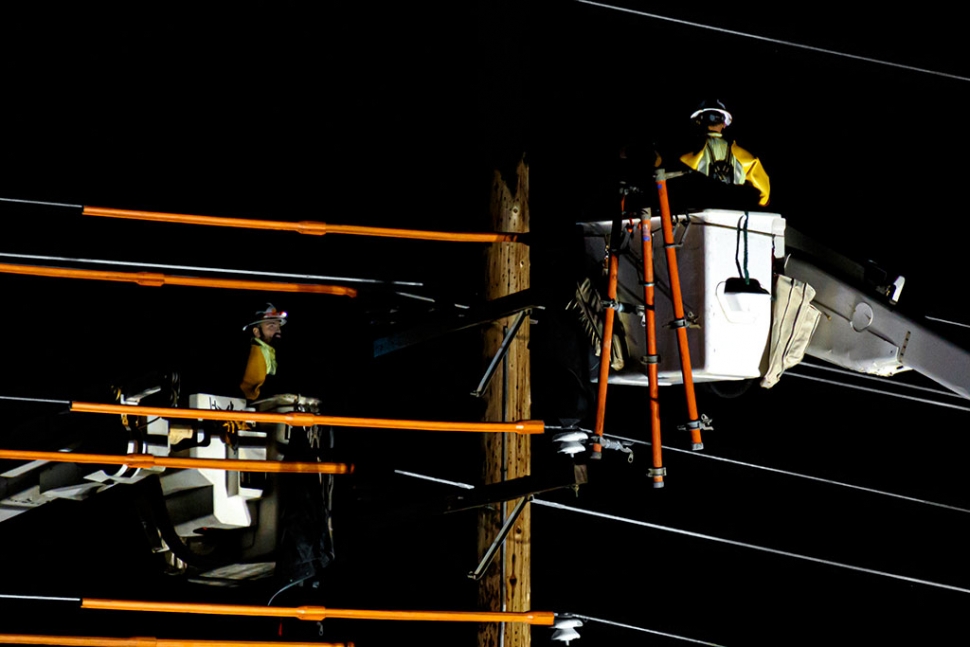|
Focus on Photography
 Photo of the Week "At midnight, workers preparing high-voltage wires for pole replacement" by Bob Crum. Photo data: Canon 7D MKII camera in manual mode, Tamron 1.4 teleconverter & 16-300mm lens @340mm. Exposure; ISO 3200, aperture f/8.0, 1/50 second shutter speed. By Bob Crum — Wednesday, July 24th, 2019
It's all about timing
 Bob Crum Last week's car show photos roused the readership in a big way: 37 emails! Most were technical, specifically about the star-shaped sunbursts, like starbursts. Alec R. asked: "How do I get that effect with my iPhone?" Alec, ALEC! You are such an incorrigible phonetographer. To capture the star-shaped sunbursts, you have to close down the iPhone camera's aperture to f/22 or smaller. Oh, wait, you can't do that on your iPhone. So sorry! Well, guess you'll just have to buy a real camera! Tom B. wrote to say: "Many of the car show photos show people. I just want to see photos of the cars." Tom, I understand. The event was so well attended I felt like I had to climb over a herd of octopuses having a committee meeting on Central Ave to get a car photo. See you there next year? The sunstars on the black Chevy photo of the week prompted Alice M. to ask: "Did you add them in Photoshop?" Alice, how could you? No, not added in PS! They were all captured in the camera. It was possible because 1, plentiful chrome on the grille, 2, the position of the car relative to the sun (car parked facing west) and the sun's position in the sky making the reflective light possible. Those elements combined resulted in a bonanza of sunstars. Since most of the questions are about the sunstars, let's again review the process. Please note, the technique is done with a camera, hardly ever possible with a cell phone. If all you have is a cellphone, see my suggestion for Alec above. Sunstars can occur while aiming the camera at the sun or from a reflected surface. If it's the sun directly, it has to be a time of day when the sun is beginning to get lower in the sky because the effect occurs when it meets a physical object. As the sun gets lower in the sky, line up an object with the sun in your camera's viewfinder. It can be a tree limb, building roof corner or a carnival ride. Stop down your camera's lens aperture to f/22 or smaller. Adjust ISO and shutter speed to maintain correct exposure. Remain mobile, i.e., constantly move back and forth until the sun barely touches the object it's next to. You'll see the sunburst rays change as you move to and fro. Make the photo at exactly the right instant. Don't stop with one photo. Shoot several as you move about changing the effect of the rays where the sun meets the object. In post-processing, you'll see that one that you made will be the best. Celebrate your achievement with your favorite beverage. Regarding reflective sunburst rays, like on the black Chevrolet's chrome, remember the two important elements: Time of day and camera position relative to the car. I needed to wait for the overcast to clear. No sunlight, no sunbursts! It's all about timing and the sun. It's great to find lost stuff. At the last place I looked, I found my long ago lost Tamron 1.4 teleconverter. A teleconverter (TC) is like a lens magnifying glass. Mounting my Tamron 16-300mm lens on the TC increases the reach to 420mm. Sweet! To test the combo, I went outside where in the dark of night, I shot two workers on cherry pickers preparing to move high-voltage wires to a new pole. But why that photo for the photo of the week? Ulterior motive? Of course! Who believes that a cell phone could have made that photo? Anyone? Point made? Happy photoing. See the car show slideshow video here: https://youtu.be/W9l2o-36j1I Send comments, suggestions or questions to: focusonphotography@earthlink.net |
